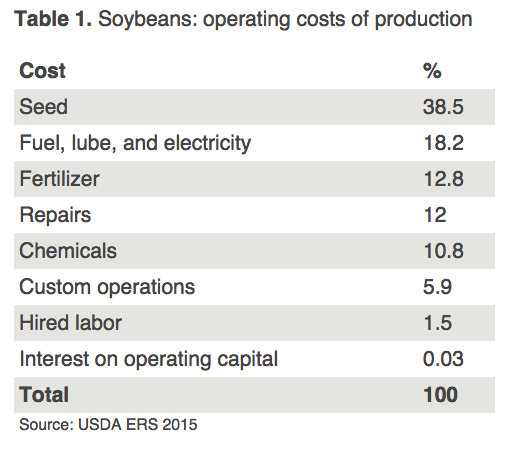By Alvaro Garcia, Extension Agriculture and Natural Resources Program Director
Corn and soybeans represent the two largest agricultural receipts of South Dakota crop production. During 2014, corn contributed almost $2.6 billion to the state’s economy followed by soybeans with nearly $2.2 billion. During the last 15 years (2000-2014) soybean acreage in the state grew from 4.37 to 5.11 million acres, or 17%. Yield increased from 35 to 45 bushels (29%) for a total of 153 and 230 million bushels for 2000 and 2014, respectively.
In 2014 there were 5.2 million acres planted to soybeans in the state, with 5.1 harvested. Yield was on average 45 bushels for a total production of 230 million bushels. Price per bushel during 2014 was $9.4. Soybean production for the 2015/16 season is projected at 3,850 million bushels, down 119 million from 2014. The U.S. season-average soybean price for 2015/16 is forecast to decline as low as $8.40 per bushel.
Calculating the breakeven cost of production is critical for soybean growers. As with any other agricultural enterprise the total cost of production can be divided into operating and overhead costs. Operating costs are basically the yearly out-of-pocket expenses, whereas the overhead costs include all other costs such as the use of capital, taxes and insurance, opportunity cost of land, etc.
According to the ERS soybean operating costs for our region were roughly $4 per bushel in 2014. Since the price paid per bushel was $9.4 then the income less operating costs was $5.4 per bushel or $243 per acre for the South Dakota average yield of 45 bushels. Table 1 shows the operating costs (including labor) as a percent of the total costs. 
The percentages in Table 1 show which areas need to be targeted to significantly alter the operating cost of production. During 2015 custom rates for tillage, planting and harvest operations have been listed 3.5% on average above 2014 rates. This was the result of higher costs of machinery, repairs and labor in spite of lower fuel prices. With current operating cost per bushel of $4 the current increase in custom operations fees represent less than 1 cent per bushel. The impact of hired labor is even four times less.
The two areas that can be targeted with the highest impact on the operating cost of production are saving fuel and selecting the right soybean seeds. Saving fuel is approximately half as effective in reducing costs as choosing the right seeds, however it can be started right away. Things as simple as timely oil changes, using low viscosity oil, maintaining the proper tire pressure, checking air filters, and replacing faulty spark plugs, can all reduce fuel consumption significantly and prolong the life of the farm equipment.
Seed selection is more than twice as effective as fuel savings to lower operating costs. This doesn’t mean to buy cheap seed, but the right seed for the field in order to maximize return on investment. According to trials conducted by the University of Illinois selecting the right soybean variety for the same location can increase yields by 20 bushels per acre. South Dakota State University Extension has soybean experts that can help growers select the right varieties to maximize yields and profits.






Post a comment
Report Abusive Comment